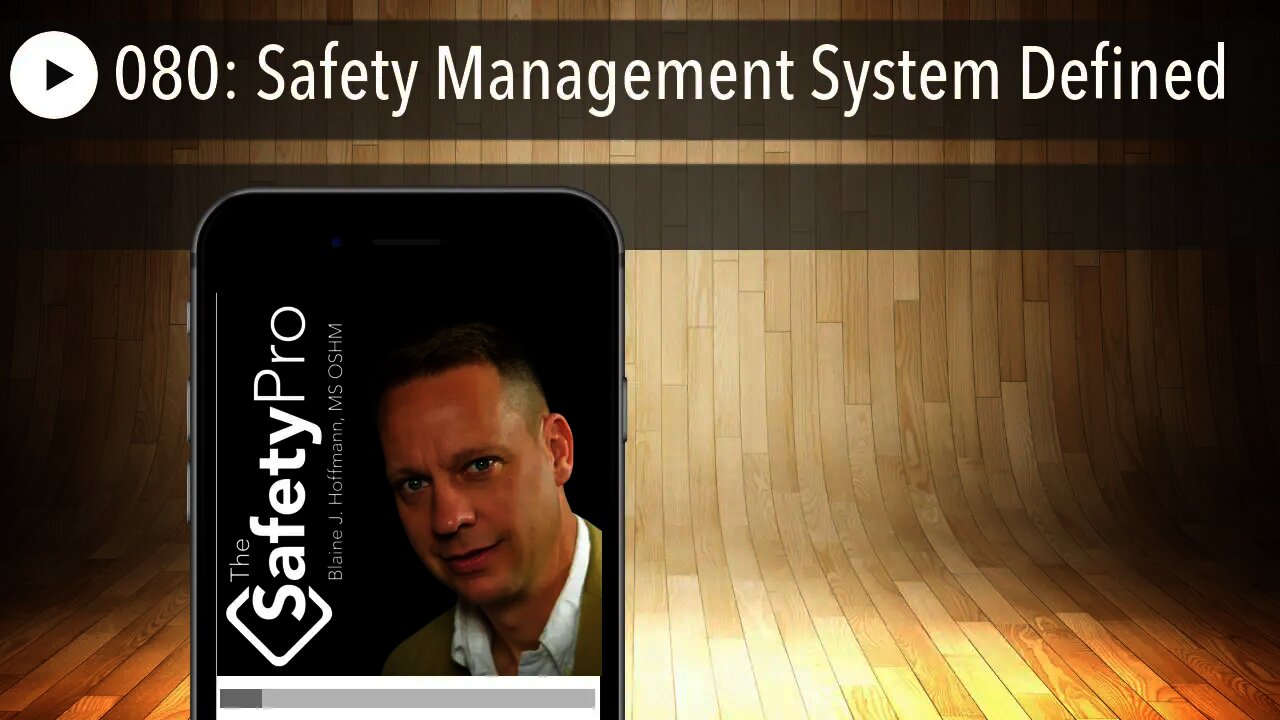Premium Only Content

080: Safety Management System Defined
Subscribe here:
http://www.thesafetypropodcast.com
Powered by iReportSource
A safety management system (SMS) is a continuous improvement process that reduces hazards and prevents incidents. It protects the health and safety of your employees and should be integrated into everyday processes throughout the organization. Investing in an SMS makes a measurable impact on your bottom line and can be viewed as a competitive advantage.
The adoption of an SMS framework and thoughtful implementation of the various pieces can have a significant impact on protecting employees and enhancing your organization’s performance and profitability. Now, safety requirements may differ across industries; the best performing organizations focus on continuous improvement that achieves the ongoing reduction of risk with a goal of zero incidents. Yes, we do sometimes have to say that. And yes, just because you have zero incidents in a given reporting period does not mean the organization is risk-free. Like I always say, no injury doesn't indicate a lack of risk. But the best companies know this so they look at the individual components of the SMS that designed to achieve just that - lowered risk which nets us lower (or none) injuries — so focusing on the how gets us to the big aspirational goal.
Ok, so let’s talk about the recent history of SMS and how it may impact the general industry and eventually construction over the years. According to the FAA , SMS is the formal, top-down, organization-wide approach to managing safety risk and assuring the effectiveness of safety risk controls. It includes systematic procedures, practices, and policies for the management of safety risks.
Since requiring it in March 2015, the FAA says Safety Management System is becoming a standard throughout the aviation industry worldwide. It is recognized by the Joint Planning and Development Office (JPDO), International Civil Aviation Organization (ICAO), and civil aviation authorities (CAA) and product/service providers as the next step in the evolution of safety in aviation. SMS is also becoming a standard for the management of safety beyond aviation. Similar management systems are used in the management of other critical areas such as quality, occupational safety, and health, security, environment, etc.
Safety Management Systems for product/service providers (certificate holders) and regulators will integrate modern safety risk management and safety assurance concepts into repeatable, proactive systems. SMSs emphasize safety management as a fundamental business process to be considered in the same manner as other aspects of business management.
By recognizing the organization's role in accident prevention, SMSs provide to both certificate holders and FAA:
• A structured means of safety risk management decision making
• A method of demonstrating safety management capabilitybefore system failures occur
• Increased confidence in risk controlsthough structured safety assuranceprocesses
• An effective interface for knowledge sharingbetween regulator and certificate holder
• A safety promotionframework to support a sound safety culture
The Public Transportation Agency Safety Plan (PTASP) Final Rule in 2018 requires individual operators of public transportation systems that receive federal funds to develop safety plans that include the processes and procedures necessary for implementing SMS. Among other requirements, the rule calls on agencies to report their Safety Management Policy and processes for safety risk management, safety assurance, and safety promotion.
And as many safety pros know, ISO has developed a standard that will help organizations to improve employee safety, reduce workplace risks, and create better, safer working conditions, all over the world. Participants in the new ISO 45001 development process used other standards such as ANSI Z10 as well as British OHSAS 18001, Canada’s CSA Z1000, and the ILO’s OHSMS guidelines. There is even talk of OSHA’s VPP getting more aligned to the ISO 45001 Standard. So you can see a definite trend emerging when it comes to SMS.
So, in 2018, knowing ISO 45001 was coming, the National Safety Council (NSC) started investigating all the common SMS frameworks and identifying all of the things they had in common. They recognized many companies were getting bogged down with questions such as: What is a safety management system? How can it help me? Which framework is right for my business? How do I go about implementing an SMS? They knew the research supported the benefits of SMS implementation, but they wanted clarity on what that looked like and a simple way to illustrate what elements constitute a successful SMS.
So let’s break down what the core features or functions look like - an effective safety management system has the following features or functions:
• People – nothing gets implemented without people who are committed, engaged, and motivated; real safety c
-
 LIVE
LIVE
LFA TV
9 hours agoLFA TV ALL DAY STREAM - MONDAY 9/15/25
13,099 watching -
 LIVE
LIVE
JULIE GREEN MINISTRIES
1 hour agoLIVE WITH JULIE
19,304 watching -
 LIVE
LIVE
The Pete Santilli Show
48 minutes agoOur Memorial & Prayer Vigil For Charlie Kirk - September 15, 2025
587 watching -
 LIVE
LIVE
Welcome to the Rebellion Podcast
20 hours agoWhere Do We Go From Here? - WTTR Podcast Live 9/15
527 watching -
 LIVE
LIVE
The Chris Salcedo Show
15 hours agoFALLOUT: Charlie Kirk's Assassination
640 watching -
 LIVE
LIVE
The Bubba Army
2 days agoCharlie Kirk's Shooter, Had a Trans BF? - Bubba the Love Sponge® Show | 9/15/25
2,733 watching -
 30:31
30:31
DeVory Darkins
14 hours ago $4.73 earnedCNN forced to admit the shocking truth about shooter as Fetterman drops bomb on Democrats
6.86K64 -
 20:54
20:54
Professor Nez
15 hours ago🚨BREAKING: Shooter’s Own Words in Charlie Kirk Case Revealed
1.79K3 -
 16:48
16:48
itsSeanDaniel
16 hours agoGenius Republican Defends Charlie Kirk and CALLS OUT The Radical Left
2641 -
 9:09
9:09
Freedom Frontline
15 hours agoFox News Just Showed The Video Biden Never Wanted Seen
4.13K15